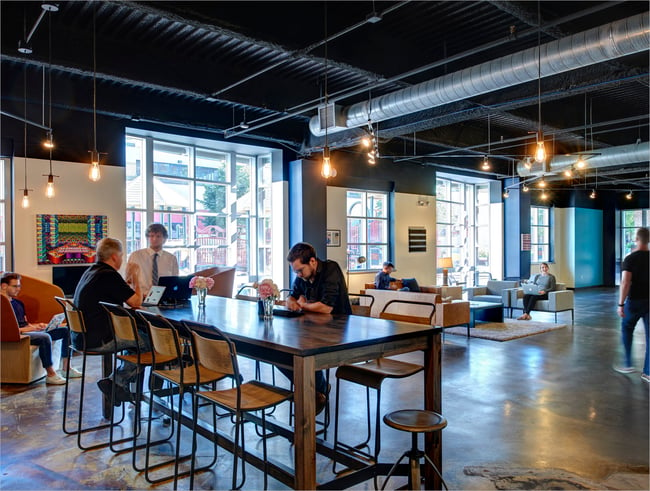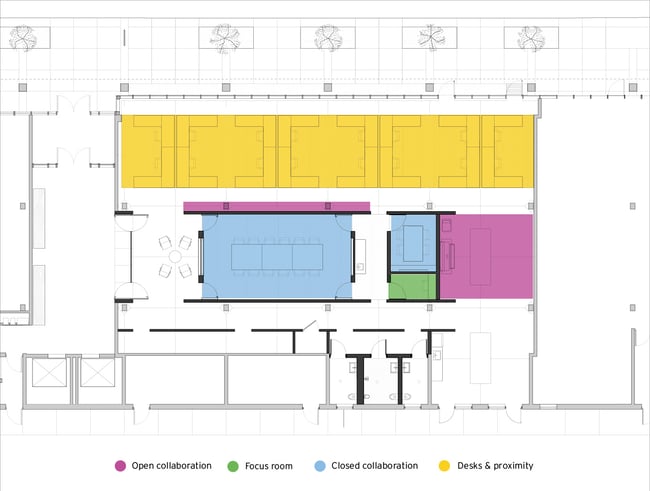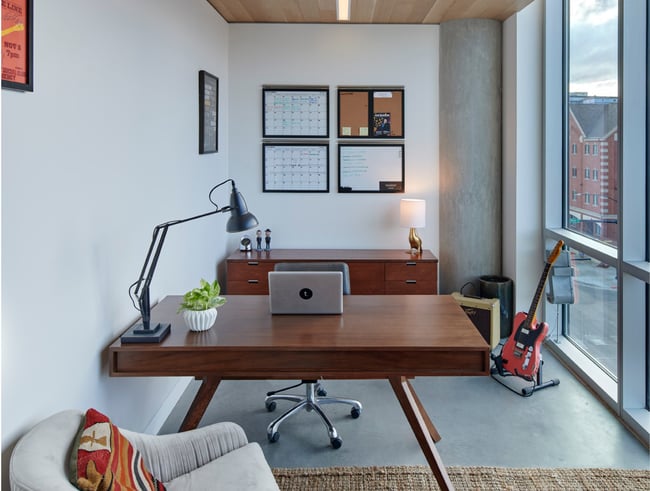Design Strategies for a Neurodiverse Workplace

Neurodiversity is an umbrella term to describe the range of differences in brain functions. It asserts that there is no one type of brain and that everyone has different ways of learning, communicating, and processing information.
In recent years—especially since the pandemic—many organizations are working to strengthen their commitment to Diversity, Equity, and Inclusion (DEI). Neurodiversity is becoming part of the conversation with organizations looking for ways to help neurodivergent individuals thrive in their roles.
Research shows workplace design is a key component of supporting neurodiversity, and this article will discuss a few of these design strategies:
- Variation in spaces
- Variation in lighting
- Intuitive wayfinding and sensory variability
It will also discuss the benefits of implementing these strategies and how they can retain talent and increase employee engagement.
Importance of Considering Neurodiversity
Before diving into specific strategies, let’s discuss the importance of considering neurodiversity in workplace design.
Some sources estimate nearly 15% of adults are considered neurodivergent, meaning they have a mental or neurological function that differs from what is considered “normal” or “typical.”
Nearly 10% of adults are diagnosed with dyslexia, and 4-5% have attention deficit hyperactivity disorder (ADHD). Another 1-2% of people have autism spectrum disorder (ASD), and many others manage conditions like anxiety, depression, obsessive-compulsive disorder, and more.
Often, these conditions go undiagnosed or are not readily apparent, but their prevalence means they should be part of workplace discussions—especially those about design.
A diversity of skills and experiences is essential to every successful organization, and neurodivergent individuals can be some of the most creative and innovative thinkers. When employees feel supported in their environment, they are more likely to stay engaged and connected to their work.
But considering neurodiversity benefits everyone. As mentioned, every brain is different. By considering the differences in how people interact, learn, and work, we can create more effective spaces.

Supportive environments can make employees more connected to their work.
3 Design Strategies for a Neurodiverse Workplace
Designing for neurodiversity is all about variation and choice. For decades, workplace design has adopted a one-size-fits-all model. Everyone received a separate cubicle or a workstation in an open office.
However, this approach limits individuals’ control over their environment. A workplace designed for neurodiversity provides a range of options, so everyone can work in a way that best suits their needs.
1. Variation in Spaces
Ideally, workplaces should provide spaces that cater to different working styles.
Acoustic distractions are a common problem in offices—but there is no one ideal solution. While some people may find an open office distracting, others may need background noise to focus. Variation in spaces gives occupants the freedom to move when they need a change of scenery.
Different types of spaces can include:
- Enclosed focus rooms
- Open collaboration spaces
- Enclosed collaboration spaces like conference rooms
- Traditional workstations in proximity
These spaces should also include different furniture options, including lounge seating, café-style seating, and adjustable workstations like sit-to-stand desks.
Variance in spaces and furniture can help people with sensory issues better manage noise levels and help everyone find a setting where they feel most productive.

Variation in spaces gives occupants more choice.
2. Variation in Lighting
Lighting is another important consideration when designing for neurodiversity.
Light quality plays a key role in managing mood, energy levels, and circadian rhythms. It also shapes our perception of space. Creating differences in lighting can help occupants feel like they are going from one space to another, allowing them to get into the right headspace for work.
Some spaces should be brightly lit to create an energizing atmosphere, while others should feel more subdued. Task lighting at workstations can also give individuals a greater sense of control.
Above all, workspaces should prioritize daylighting, which provides natural variations throughout the day and year.

Different lighting options provide a greater sense of control.
3. Intuitive Wayfinding and Sensory Variability
Predictability and intuitive wayfinding create a sense of control and help occupants manage anxiety.
Clear boundaries and consistent materials can make workplaces easier to navigate. Additionally, sightlines to exits, mezzanines, and circulation spaces can assist our brains’ innate positioning systems and improve spatial awareness.
While wayfinding is important, workplaces should feel engaging and creative. Adding moments of discovery or “delight” can strengthen occupants’ experience.
One strategy is using the principle of “conceal and reveal.” Seeing an entire space at once diminishes a sense of discovery. Instead, design elements should play off each other to create a series of unfolding experiences.
For example, locating objects like reception desks or hospitality bars between an entrance and an open office welcomes people into the space while partially concealing the desk area. Creating lower ceilings at entrances can give a sense of compression and make adjacent spaces seem more open.
Another strategy is creating visual connections to the outdoors through sightlines and daylighting. Strategically placing apertures to frame the landscape can invite occupants to see their surroundings from a new perspective.
In short, variation applies to all levels. While the workplace should be easy to navigate, it should provide enough sensory variability to keep occupants curious and engaged.
Learn More About Workplace Design
Inclusivity is not only the right thing to do, but it’s also smart business sense. Creating an environment where everyone feels engaged and supported can strengthen employees’ connection to your organization and improve talent attraction and retention rates.
Ultimately, designing for neurodiversity means providing choice and control. The workplace should accommodate different workstyles, personalities, and abilities, so everyone can find a setting that suits their needs.
Variation in spaces, lighting, and seating also benefits organizations adjusting to hybrid work models. Learn more by reading about trends in post-pandemic office design.